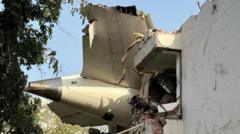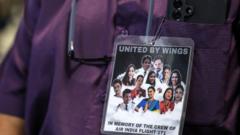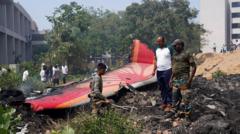The recent Air India-171 crash, which resulted in the loss of 270 lives, has thrown the future of the airline's revival into chaos. Investigations are ongoing, but the company, owned by the Tata Group, now faces significant challenges as it works to regain passenger trust while managing operational setbacks and reputation damage. All eyes are on how the airline will navigate the aftermath of the tragedy, with industry experts warning that recovery will take considerable time and effort.
Air India Faces Uncertain Future Following Devastating Crash

Air India Faces Uncertain Future Following Devastating Crash
As Air India grapples with the fallout from a tragic crash, questions arise about the airline's ambitious turnaround plans.
The devastating Air India-171 crash has left 270 victims' families in mourning and plunged the airline into an uncertain crisis. In the wake of this tragedy, global investigators are working diligently to determine the cause. It remains too early to assign fault, and the investigation could span several months. As the Tata Group, which took ownership of the airline from the Indian government in 2022, strives for a major overhaul, the crash has disrupted its recovery efforts at a pivotal moment.
In the months leading up to this disaster, Air India had begun to see positive changes under Tata leadership. Operating profits were reported alongside a reduction in customer complaints, signaling progress after years of state neglect. Investments in modernizing the fleet with new aircraft and improved customer service hinted at a bright future. However, in light of the recent tragedy, the airline now faces a grim reality.
Public sentiment has shifted dramatically, with many hesitant to fly Air India following the crash. Despite a solid safety record, fears are palpable, leading to cancellations and a potential drop in bookings that could further hinder recovery attempts. Adding to this is a series of operational challenges, including technical issues and safety threats that have surfaced in recent days, leaving experts concerned about the airline's reputation.
“With the tragic loss of lives, skepticism about flying Air India is likely to linger,” said Jitendra Bhargava, a former executive director with the airline. “Efforts to turn around this flag carrier, already hampered by legacy issues, may now take a backseat.” The reshuffling of resources in response to this crisis—covering legal, insurance, and reputational damage—could slow the turnaround even further, leading experts to draw comparisons to Malaysia Airlines' lengthy recovery after its twin tragedies in 2014.
As Air India cancels a percentage of its international services and undergoes heightened safety inspections, the specter of the crash looms large over everything from operations to management. The investigation's findings, alongside increased global scrutiny, force the airline to confront uncomfortable questions about its operational and maintenance practices. The path forward will require deft management and transparent communication to restore confidence in the brand—a task that is more challenging in turbulent times.
Tata Group chairman N Chandrasekaran's recent town hall meeting signifies a commitment to resilience amid adversity. He characterized the crash as the "most heartbreaking" challenge of his career, emphasizing the need for safety improvements. Industry analysts remain cautiously optimistic, pointing to the large pool of talented pilots and engineers within Air India, believing that flying standards will soon be elevated.
Tapping into its partnership with Singapore Airlines, known for excellence in aviation, could also aid in Air India's recovery journey. The collective expertise may help the airline navigate these troubled waters, but time will be the ultimate test. Moving forward, consistent communication and decisive action will be critical as Air India endeavors to earn back the trust of its passengers and secure its place within India's rapidly expanding aviation market.
In the months leading up to this disaster, Air India had begun to see positive changes under Tata leadership. Operating profits were reported alongside a reduction in customer complaints, signaling progress after years of state neglect. Investments in modernizing the fleet with new aircraft and improved customer service hinted at a bright future. However, in light of the recent tragedy, the airline now faces a grim reality.
Public sentiment has shifted dramatically, with many hesitant to fly Air India following the crash. Despite a solid safety record, fears are palpable, leading to cancellations and a potential drop in bookings that could further hinder recovery attempts. Adding to this is a series of operational challenges, including technical issues and safety threats that have surfaced in recent days, leaving experts concerned about the airline's reputation.
“With the tragic loss of lives, skepticism about flying Air India is likely to linger,” said Jitendra Bhargava, a former executive director with the airline. “Efforts to turn around this flag carrier, already hampered by legacy issues, may now take a backseat.” The reshuffling of resources in response to this crisis—covering legal, insurance, and reputational damage—could slow the turnaround even further, leading experts to draw comparisons to Malaysia Airlines' lengthy recovery after its twin tragedies in 2014.
As Air India cancels a percentage of its international services and undergoes heightened safety inspections, the specter of the crash looms large over everything from operations to management. The investigation's findings, alongside increased global scrutiny, force the airline to confront uncomfortable questions about its operational and maintenance practices. The path forward will require deft management and transparent communication to restore confidence in the brand—a task that is more challenging in turbulent times.
Tata Group chairman N Chandrasekaran's recent town hall meeting signifies a commitment to resilience amid adversity. He characterized the crash as the "most heartbreaking" challenge of his career, emphasizing the need for safety improvements. Industry analysts remain cautiously optimistic, pointing to the large pool of talented pilots and engineers within Air India, believing that flying standards will soon be elevated.
Tapping into its partnership with Singapore Airlines, known for excellence in aviation, could also aid in Air India's recovery journey. The collective expertise may help the airline navigate these troubled waters, but time will be the ultimate test. Moving forward, consistent communication and decisive action will be critical as Air India endeavors to earn back the trust of its passengers and secure its place within India's rapidly expanding aviation market.























